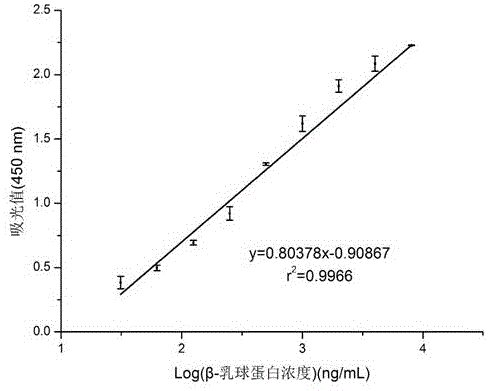A method for detecting milk β-lactoglobulin and its allergenic residues based on colloidal gold probe
A lactoglobulin and probe detection technology, applied in the field of food analysis, achieves the effect of convenient high-throughput detection, good promotion and application prospects, and short detection time
- Summary
- Abstract
- Description
- Claims
- Application Information
AI Technical Summary
Problems solved by technology
Method used
Image
Examples
Embodiment 1
[0031] Example 1: Quantitative detection of the content of the allergen β-lactoglobulin in sunshine pure milk.
[0032] 1. Sample pretreatment.
[0033]Take 1 mL of sunshine pure milk at 10,000×g, centrifuge at 4 °C for 15 minutes to remove fat, and dilute the supernatant 10,000 times with blocking solution as a test sample.
[0034] 2. Sample testing.
[0035] (1) Covalent immobilization: After mixing the EDC-activated monoclonal antibody (8 μg / mL) with an equal volume of 4% APTES, add 100 μL per well to a hydroxylated microtiter plate, and covalently fix at 37 °C. Fixed for 1 h.
[0036] (2) Washing: wash with PBST (containing 0.1% Tween-20) 3 times, each time for 3 min, and tap dry.
[0037] (3) Blocking: Use PBS with 2% gelatin (containing 0.1% Tween-20) blocking solution, add 250 μL to each well, and incubate at 37 °C for 0.5 h. After blocking, wash with PBST 3 times, each time for 3 min, and blot dry.
[0038] (4) Antigen addition: gradiently dilute the β-lactoglobu...
Embodiment 2
[0045] Example 2: Quantitative detection of β-lactoglobulin allergenic residues in partially hydrolyzed infant milk powder of Dumex Premium Care.
[0046] 1. Sample pretreatment.
[0047] Weigh 0.2 g of Dumex Premium Partially Hydrolyzed Infant Milk Powder, add blocking solution and fully dissolve to make the protein concentration 5 mg / mL. Centrifuge at 10,000×g for 15 minutes at 4 °C to remove fat and precipitates, and dilute the supernatant to 250 μg / mL, 50 μg / mL and 10 μg / mL with blocking solution as test samples.
[0048] 2. Sample testing.
[0049] (1) Covalent immobilization: After mixing the EDC-activated monoclonal antibody (8 μg / mL) with an equal volume of 4% APTES, add 100 μL per well to a hydroxylated microtiter plate, and covalently fix at 37 °C. Fixed for 1 h.
[0050] (2) Washing: wash with PBST (containing 0.1% Tween-20) 3 times, each time for 3 min, and tap dry.
[0051] (3) Blocking: Use PBS with 2% gelatin (containing 0.1% Tween-20) blocking solution, add...
Embodiment 3
[0059] Example 3: Quantitative detection of β-lactoglobulin content in Leibniz Choco Minis chocolate.
[0060] 1. Sample pretreatment.
[0061] Grind Leibniz Choco Minis chocolate into powder, weigh 1.0 g of powder, add 20 mL of extraction solution (20 mmol / L Tris-HCl, 2% Tween-20, pH 8.0), stir overnight at 4 °C to extract protein. The extract was centrifuged at 10,000 g4 °C for 15 min to remove fat and precipitates, and the supernatant was diluted 500 times with blocking solution as a test sample.
[0062] 2. Sample testing.
[0063] (1) Covalent immobilization: After mixing the EDC-activated monoclonal antibody (8 μg / mL) with an equal volume of 4% APTES, add 100 μL per well to a hydroxylated microtiter plate, and covalently fix at 37 °C. Fixed for 1 h.
[0064] (2) Washing: wash with PBST (containing 0.1% Tween-20) 3 times, each time for 3 min, and tap dry.
[0065] (3) Blocking: Use PBS with 2% gelatin (containing 0.1% Tween-20) blocking solution, add 250 μL to each we...
PUM
 Login to View More
Login to View More Abstract
Description
Claims
Application Information
 Login to View More
Login to View More - R&D
- Intellectual Property
- Life Sciences
- Materials
- Tech Scout
- Unparalleled Data Quality
- Higher Quality Content
- 60% Fewer Hallucinations
Browse by: Latest US Patents, China's latest patents, Technical Efficacy Thesaurus, Application Domain, Technology Topic, Popular Technical Reports.
© 2025 PatSnap. All rights reserved.Legal|Privacy policy|Modern Slavery Act Transparency Statement|Sitemap|About US| Contact US: help@patsnap.com

